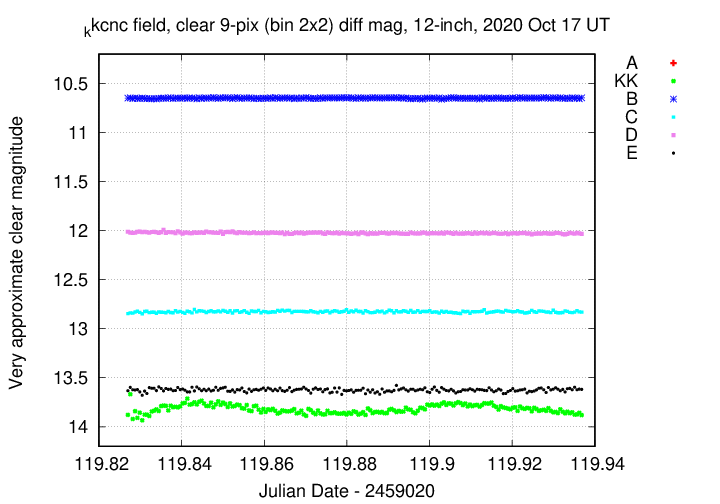
On the night of Oct 16/17, 2020, under conditions that ranged from poor (in first half of the night = RT And) to good (second half of the night = KK Cnc), I acquired images of the star KK Cnc , as well as data on RT And. I also took some images of Mars, which I hope will reveal some surface features -- just for fun.
KK Cnc has faded a bit, reaching an average of CV = 13.8 during this run, but it shows clear superhumps with a period of about 0.6 days and an amplitude of about 0.1 mag.
You can find some basic information on this star at the SIMBAD page.
The main setup was:
Notes from the night:
The object is at
RA = 08:07:14.25 Dec = +11:38:12.5 (J2000)
A chart of the field is shown below. The size of the chart is about 16 x 16 arcminutes.

I've marked the location of several comparison stars.
star ID B V ------------------------------------------------------------------------- A APASS 53280329 11.356 10.028 C APASS 53295398 13.350 12.827 (mags from AAVSO) --------------------------------------------------------------------------
I used star "C" to shift the instrumental magnitudes to the V-band scale, following the values given for this star in the AAVSO chart X25677BDK.
I took a photo of the finder TV's screen when pointing to KK Cnc; this could be a useful reference for the future:

I ran the camera at the normal temperature of -20 C. Nothing out of the ordinary.

I took a series of 192 exposures of the field, using no filter and an exposure time of 40 seconds. Some images were slightly trailed, but I think the gain in signal was worth it.
The sky value shows no sign of clouds.

The number of objects detected.

I used an aperture with radius 9.0 pixels tonight.


Using aperture photometry with a radius of 9 pixels (binned 2x2, each pixel is 1.25 arcsec, so a radius of 11.25 arcsec), I measured the instrumental magnitudes of a number of reference stars and the target. Following the procedures outlined by Kent Honeycutt's article on inhomogeneous ensemble photometry, I used all stars available in each image to define a reference frame, and measured each star against this frame.
Sigma-vs-mag plots show that the floor was about 0.003 mag overall. KK Cnc is the outlier at around instrumental mag 4.1.

Here are light curves of the variable and the field stars.

I used the AAVSO value for the V-band magnitude of star "C" = APASS 53295398 to shift the ensemble UNFILTERED magnitudes to the standard V-band scale, based on the AAVSO's table of V magnitudes.
Here's a closeup on the variable.

You can download my measurements below. A copy of the header of the file is shown to explain the format.
# Measurements of KKCnc made at RIT Obs, UT 2020 Oct 17, # in good conditions, # by Michael Richmond, # using Meade 12-inch LX200 and ATIK 11000. # Exposures 40 seconds long, clear filter. # Tabulated times are midexposure (FITS header time - half exposure length) # and accurate only to +/- 1 second (??). # 'mag' is a differential magnitude based on ensemble photometry # using a circular aperture of radius 9 pix = 11.2 arcseconds. # which has been shifted so 000-BKD-933 has mag=12.827 # which is its V-band magnitude according to AAVSO chart X25677BDJ. # # UT_day JD HJD mag uncert Oct17.32700 2459139.82700 2459139.82627 13.879 0.025 Oct17.32758 2459139.82758 2459139.82685 13.668 0.020 Oct17.32815 2459139.82815 2459139.82742 13.921 0.026
One of our physics majors, Evan Muskopf, is studying the light curve of the eclipsing binary system RT And for his capstone project. I acquired B-band images of the field over a span of about 0.26 days, and caught one of the minima cleanly in the middle of my measurements. Hooray!
Last modified 10/17/2020 by MWR.